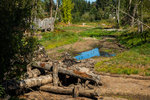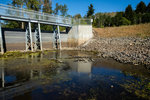





Before he retires to teach his granddaughter Tatum to play golf, Centralia Public Works Director Kim Ashmore wants to win the fight against flooding.
Though he knows the Chehalis River Basin will remain in the battle long after he’s gone, he has capitalized on his opportunity to help the Centralia community.
When Ashmore, 59, began working for the city in the 1980s, he was already well aware of the threat posed by the creek. Much of his work as director has been defined by China Creek, including the “It’s Your Creek” sign campaign and his creation of the Centralia Stream Team, which walks through the creek twice a year and picks up litter.
Thanks to willing city council members and funding through the Chehalis Basin Board, Ashmore has headed the China Creek Flood and Habitation Protection Project since around 2019.
“Not every project needs to be a dam to provide some benefit,” he said, summarizing the work as “changing the layout of the land, removing some material, creating more storage, that’s why it’s called a local project. It’s not a dam that affects the entire basin. It’s a project that helps Centralia. … We've been fortunate. We've received a little over $5 million for phase one and phase two over the past six years now to help with flooding and try to improve fish habitat.”
In July, the second phase of the project was completed. To retain water, the creek has been essentially dammed, with an opening in the bottom of the wall to allow fish to pass throughout the year. China Creek is home to bluegills, bass and salmon, along with many other species including nutrias, beavers and waterfowl.
Ashmore says with phase two complete, the project would reduce flow depth during a 2.5 inch 24-hour rainfall by 3.6 inches while improving habitat for salmon year-round.
“Which doesn’t seem like a lot. But when a business has that much water in their floor and you reduce it, now they don’t have water. That’s the goal,” Ashmore said, adding that if that much water is held back by the project, “We’re winning.”
Hopefully, the first big test for the flow control structure will not arise in the coming winter. But if it does, Centralia will have more protection from China Creek flooding than it has since the creek was dug.
Phase three of the project, Ashmore said, would be a 48-inch culvert under Gold Street where it crosses Vinegar Valley. If completed, it would essentially provide more space for water to sit during a flood event. Phase four would allow clearing the creek channel up Little Hanaford Road.
“I hope I’m still here when it happens, but we’ll see,” he said.
The four-step project is at a standstill currently, but one piece of big news will be announced by the Chehalis Basin Board at Tuesday’s Centralia City Council meeting, Ashmore said, which is the upcoming installation of a USGS river gage on China Creek.
With that, the public will be able to track creek levels as they can with the Chehalis and Skookumchuck rivers. Over time and research, this will provide the ability to predict flood damage and road inundation during major storms. Gages can mean the difference between safety or being stranded in a flooded neighborhood without warning.
And to Ashmore, the list of successes of the China Creek project doesn’t end with phase two’s completion. With the work done around the former Agnew Mill, which was donated to the City of Centralia by the Agnew family in the last few years, there is now a walking trail that was completed in April with a bridge over the creekbed where the retention wall stands.
While Ashmore led The Chronicle on a tour of the property Wednesday afternoon, Centralians stopped to provide comments on their love for the trail.
“My favorite part of this is it’s like a slice of nature, and my house is only three minutes that way,” said Tyler Ferguson.
His walking companion, Micah Harvey, said “I can just feel the wind blowing and it’s just really peaceful. There’s not a lot of people who come here, at least all at one time. Sometimes you’ll find some dogs and you’ll see the geese flying. It’s really nice.”
Another added benefit Ashmore noted in the last few weeks was the Department of Natural Resource (DNR) helicopters’ use of pond water on the lot to put out a fire near the railroad tracks north of Centralia.
He related DNR’s use of the water to the way the community responds to flooding and ultimately, the goal of the project: “We’re going to do whatever it takes to protect life. It’s not, ‘Oh hey Mother Nature’s gonna flow right through here. Your house is gonna get washed away. If you go with it, no biggie.’ No. We have to protect life first.”